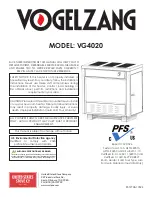
7
Fig. 4 - Arranging the Flue Plug for Top or Rear Outlet
HEARTH
The construction of the hearth must conform to Building Regulations, must be firm, non-
combustible and capable of supporting the stove. (Refer to Building Regulations Document J).
FLUE CONNECTION
The flue pipe used to connect the stove to the chimney is 125mm (5") in diameter. The
stove is supplied ready for top flue connection. To change to rear connection the flue
blanking plug supplied with the stove is used to block the top flue outlet. The blanking plug
in the rear flue connection must then be removed (to access the bolts attaching the rear
flue connection the convector panel must first be removed) - see Fig. 4. A rear flue box
attachment is also available from ACQUISITIONS that allows the stove to be installed
further out of any building recess. Fig. 1 shows suitable flue connections.
IMPORTANT INSTALLATION NOTES
1.
The installation must allow for adequate chimney sweeping.
2. Avoid using bends greater than 45° to the vertical. All flue pipe sections should be as
close to vertical as possible.
3. All joints in the flue system must be effectively sealed.
4. All flue sockets must face upwards.
5. Check the appliance for soundness of seals between castings and main components
and that all supplied parts and fittings are correctly fitted.
On completing the installation, check that all the internal components of the stove are
positioned correctly.
Check - ashpan, iron grate, baffle, side and back bricks.
6
A flue stabiliser can be fitted to reduce the draught through the stove if the flue draught is
too high. The flue stabiliser should be:
•
Fitted in the same room as the stove.
•
The same size as the flue pipe.
•
Fitted no closer than 700mm to the flue outlet of the appliance.
Fig. 3 - Stove Dimensions
POSITIONING
The overall dimensions of the stove are shown in Fig. 3. The table above indicates
recommended distances between the stove and surrounding combustible materials. As a
rule, any surrounding combustible material should not exceed 80°C. There should be
sufficient space around the stove for service work.
DIMENSIONS & CLEARANCES
INSTALLING THE STOVE
FLUE STABILISER
ACQUISITIONS
NOTE
All dimensions are in millimetres
























